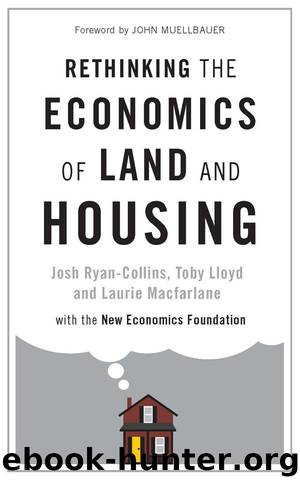Rethinking the Economics of Land and Housing by Josh Ryan-Collins

Author:Josh Ryan-Collins [Ryan-Collins, Josh]
Language: eng
Format: epub
Publisher: Zed Books
Published: 0101-01-01T00:00:00+00:00
5.4 The history of mortgage and real estate finance in the UK
Building societies and mutual home loans
You might have wondered where the term ‘building society’ comes from. The clue is in the name. Building societies used to finance the building of new homes for their members. Building societies first emerged in the UK in the Midlands in the late eighteenth century, an area that was undergoing rapid economic expansion driven by small metalworking firms whose highly skilled and reasonably wealthy owners wished to invest in property Members of a society would pay a monthly subscription to a central pool of funds which was used to finance the building of houses for members. These homes would, in turn, act as collateral to attract further funding to the society, enabling further construction (Clark, 2001).
Building societies are ‘mutuals’ – financial institutions that are owned by their members and run in the interests of their members rather than private owners or shareholders. Most of the original societies were self-terminating. When every member of the society had a home, their job was done and they closed themselves down.7 Their sole purpose was the provision of physical shelter to their members. Under such an arrangement, there was a fairly stable relationship between incomes and the price of homes – after all, it was the cooperative pooling of such incomes which provided most of the money to build the homes.
In the 1840s building societies began to accept savings from members who were not necessarily potential homeowners and permanent building societies emerged which would continue to take in savings and offer loans on a rolling basis, taking on new members as earlier ones completed purchases. By 1860 there were over 750 building societies in existence in London and 2,000 in the provinces and by 1910 over 1,723 societies with 626,000 members and total assets of £76 million (BSA, 2015). Virtually every town in the country had a society named after it.
Over time, many building societies merged, enabling the pooling of liquidity that allowed for larger home building schemes and mortgage financing that was not dependent on local savings (see Box 5.3). Building societies began to pay interest on savings. Building society loans carried risk since they were lending at longer maturity than their deposits – they were creating credit and money in just the same way as banks (see Box 5.1 above). For example, mortgage loans would last five, ten or fifteen years but customers could withdraw their savings more rapidly (see Box 5.3).
However, with the odd exception related to fraudulent activity, there were few examples of building societies failing on ‘runs on the bank’. There were a number of reasons for this. The building societies business model was about attracting savers with whom they would have a long-term relationship and a need for a regular but secure income from these savings. The model aligned the needs of younger savers who wished to secure a deposit on a home and older retired people who were looking for a secure income for their savings.
Download
This site does not store any files on its server. We only index and link to content provided by other sites. Please contact the content providers to delete copyright contents if any and email us, we'll remove relevant links or contents immediately.
International Integration of the Brazilian Economy by Elias C. Grivoyannis(74992)
The Radium Girls by Kate Moore(11621)
Turbulence by E. J. Noyes(7702)
Nudge - Improving Decisions about Health, Wealth, and Happiness by Thaler Sunstein(7244)
The Black Swan by Nassim Nicholas Taleb(6770)
Rich Dad Poor Dad by Robert T. Kiyosaki(6179)
Pioneering Portfolio Management by David F. Swensen(6081)
Man-made Catastrophes and Risk Information Concealment by Dmitry Chernov & Didier Sornette(5650)
Zero to One by Peter Thiel(5494)
Secrecy World by Jake Bernstein(4389)
Millionaire: The Philanderer, Gambler, and Duelist Who Invented Modern Finance by Janet Gleeson(4099)
The Age of Surveillance Capitalism by Shoshana Zuboff(3989)
Skin in the Game by Nassim Nicholas Taleb(3968)
The Money Culture by Michael Lewis(3849)
Bullshit Jobs by David Graeber(3833)
Skin in the Game: Hidden Asymmetries in Daily Life by Nassim Nicholas Taleb(3724)
The Dhandho Investor by Mohnish Pabrai(3561)
The Wisdom of Finance by Mihir Desai(3526)
Blockchain Basics by Daniel Drescher(3330)
